Having never really taken the time to look at ancient shoes (I have only three pair of shoes myself — black, brown and a pair running shoes), I was very impressed with the creativity and design of shoes from centuries ago. Most of the shoes you see in this post are English, and can be found at the Victoria and Albert Museum online collections site. While I can imagine that the earliest shoes of ancient, everyday people to be mostly functional and utilitarian, I guess it is fair to say that the most beautifully crafted shoes — the ones with the most decorative appeal — were made for the (dare I say it?) well-heeled of society. That rings true today I guess, as some things never seem to change.
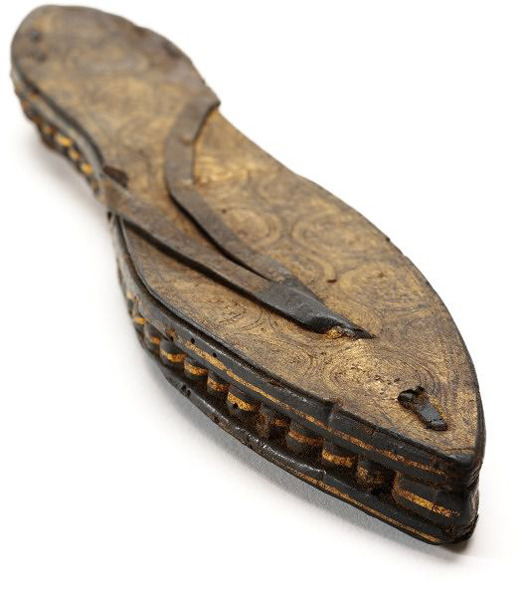
Egypt (made)
ca. 30 BC - AD 300 (made)
A tanned leather and papyrus sandal with gilding, carving, incising, dyeing and punchwork.
A raised sandal, pointed toe and semi- pointed heel. Egyptian, ca. 30 BC - AD 300 (possibly). Worn. Treadsole: Layer of packed papyrus (?) 3mm thick. Outer edge wrapped with a strip of black leather 8mm wide. Strip missing from waist down. Grain of fibre runs vertically. Thin strip of gold painted around side perimeter. Blackened. Some small holes. Broken at waist. Midsole: Layer of 15mm thick, tightly packed papyrus ?.
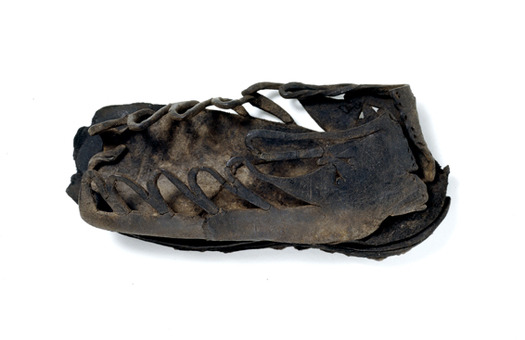
Roman Britain, probably 1st or 2nd century AD
Found on the site of the Bank of England, London
This small shoe, from a waterlogged deposit in London, probably belonged to a child. It has a thick hob-nailed sole and decorative openwork on the upper.
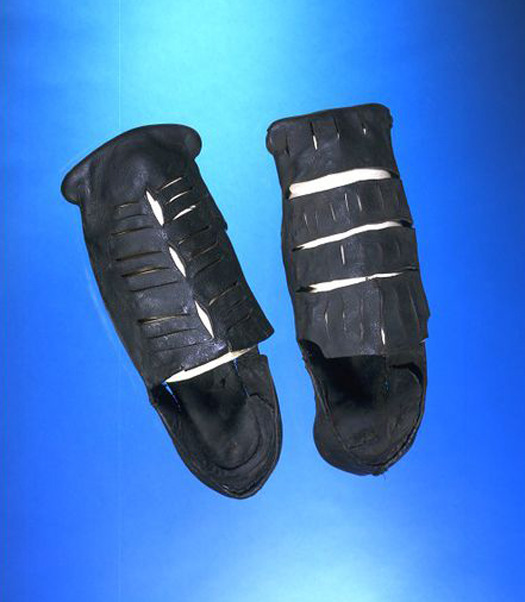
London, England (probably, made)
1520s - 1540s (made)
Hand-sewn tanned leather
This man's leather shoe has a broad, square 'horned' toe. This style was fashionable during the reign from 1509-1547 of Henry VIII . It was a complete change from the very pointed toe favored at the end of the 15th century. The wide shoes echoed the line of fashionable dress for men, who wore broad-shouldered padded jackets called doublets. The slashed decoration made the leather more flexible and therefore more comfortable to wear. The shoes originally had bright colored linings which could also be glimpsed through the slashes. This shoe has both horizontal and vertical slashes but the lining has not survived. The shoe described is the one you can see on the right.
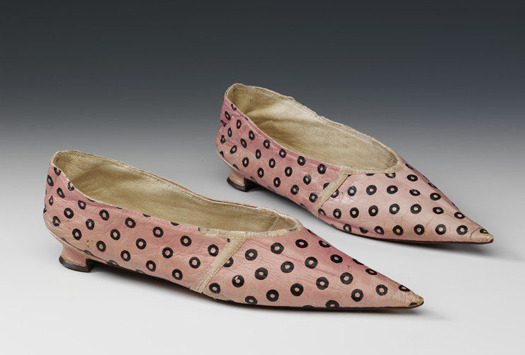
Great Britain, United Kingdom (made)
ca. 1800 (made)
Leather, with stenciled decoration
This style of heeled shoe, made of pastel colored kid leather with painted or stenciled patterns, with an exaggerated pointed toe, was popular in the latter years of the 18th century. It was much simpler than previous women's styles which had tended to be made of leather, have a pronounced heel. They had often been made of fabric. In 1801, the Lady's Magazine illustrated just such spotted kid shoes.
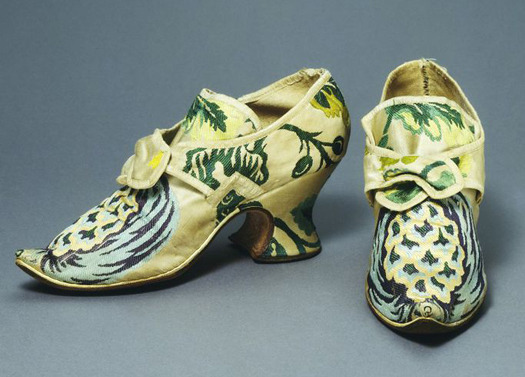
Spitalfields, England (textile, woven)
England, Great Britain (made)
ca. 1735 (made)
Brocaded silk, lined with leather, grosgrain ribbon and polished steel
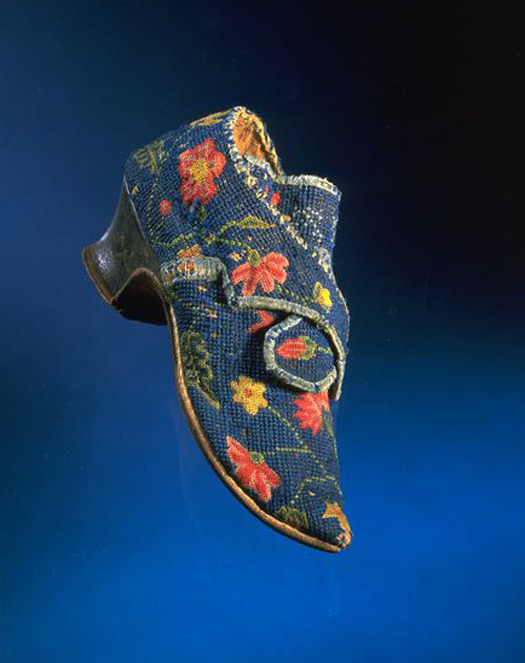
Great Britain, United Kingdom (made)
1730s-1740s (made)
Linen canvas, embroidered with wool
This pair of women's shoes have linen canvas uppers. They are embroidered with flowers in colored wools in cross stitch and tent stitch. This was a period when fashionable shoes often echoed the pattern of the dress with which they were worn. The shoes have pointed toes and a short, waisted heel that is made of wood and covered with leather. The latchets (straps that fastened across the instep) were originally fastened with buckles. Buckles were separate items and owners often transferred them from one pair of shoes to another. This is why so many pairs of shoes have survived without buckles, as in this case.
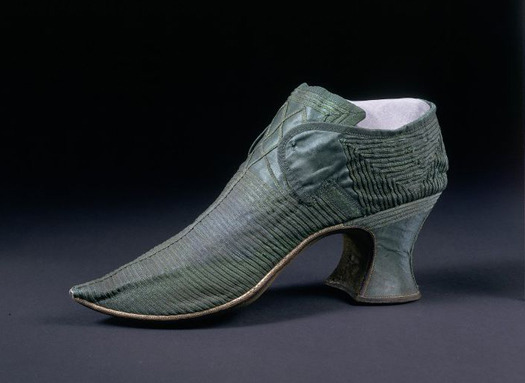
England, Great Britain (made)
ca. 1710 (made)
Leather sole, covered wooden heel, and satin trimmed with silk braid
The upper of this shoe is composed of green silk, which envelops the heel as well. The shoe is lined with white leather and beige silk. A narrow braid of green silk covers the upper in parallel lines.
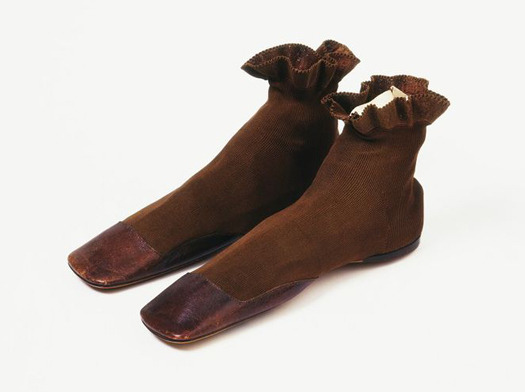
Germany (possibly, made)
Great Britain, United Kingdom (possibly, made)
ca. 1851 (made)
Silk stockinette, leather, lined with silk, cotton, hand-stitched
Ankle boots were introduced in about 1804 as fashionable women's wear. The fashion for square toes lasted from 1825 to the 1870s. These boots are made for the left and right foot. However, until 1900, many women continued to wear straights (shoes which were not shaped to distinguish between left and right so that they could be worn on either foot).
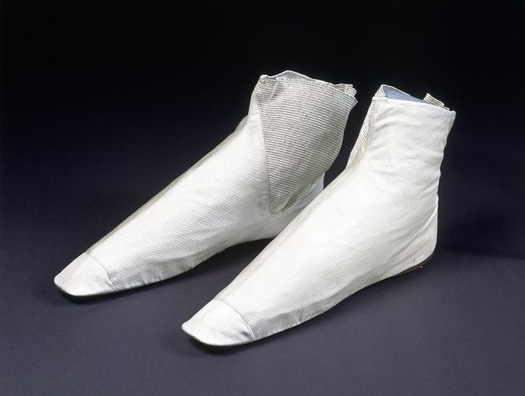
Germany (possibly, made)
Great Britain, United Kingdom (possibly, made)
ca. 1851 (made)
Silk grosgrain, leather, elastic, lined with cotton
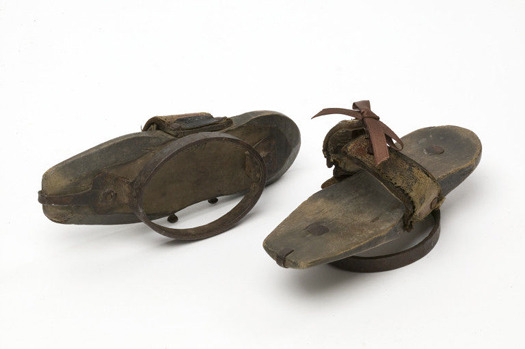
United Kingdom (made)
1780-1820 (made)
Wooden soles; leather straps; iron rings
The patten as a type of protective footwear dates back at least to Roman times. They have been worn mainly for the practical purpose of protecting shoes and feet coming into contact with mud, puddles, or street rubbish, but have also been fashion items when made in more sumptuous materials. This particular pair are of the later type with a wooden sole mounted above a metal ring, the whole thing worn over a pair of shoes and keeping the wearer's feet about an inch above the ground: this pair of pattens probably dates from 1780-1810, but the earliest printed mention of this type with the metal ring beneath is in 1575.
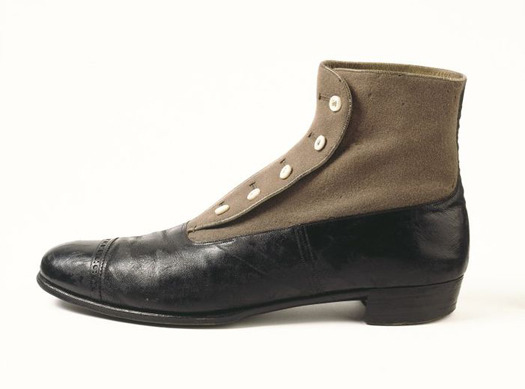
London, England (made)
1890-1900 (made)
Cloth and patent leather, with pearl buttons, machine and hand-sewn by Thomas of St. James' Street (maker)
Boots were still more commonly worn than shoes by men throughout the 19th century, and were regarded as more formal for day wear. Half-boots were usually worn under the trousers.
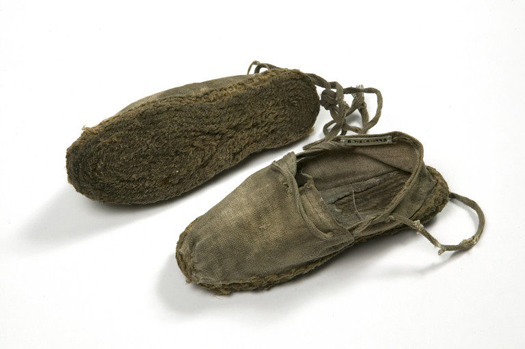
Great Britain, United Kingdom (made)
about 1885 (made)
Canvas with rope soles
Pair of little girl's beach shoes, with white canvas uppers and flat rope soles. The throat of each shoe is square cut, and the upper edges are threaded with drawstring tapes to adjust the fit, and tie round the ankles.
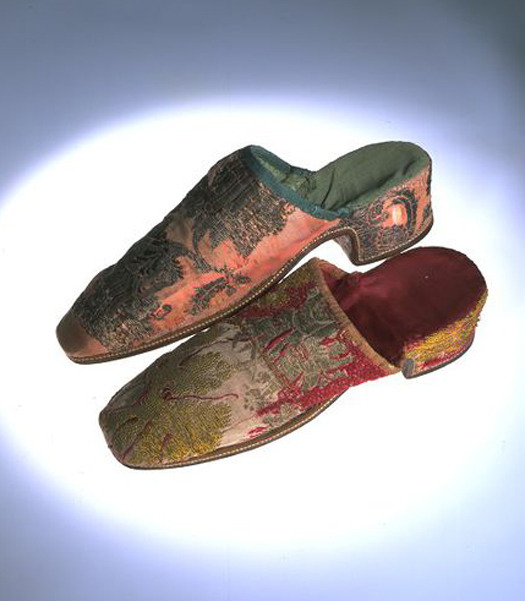
Great Britain, United Kingdom (made)
1710-1720s (made)
Leather sole and heel, with brocaded silk uppers
Gentlemen would have worn these mule slippers with a nightgown. They wore these informal gowns when relaxing at home or receiving visitors. The slippers have the square toe and low heel that were fashionable in the early 1700s. They are brocaded with rich metal thread. The mule you can see at the top is one of the pair described.
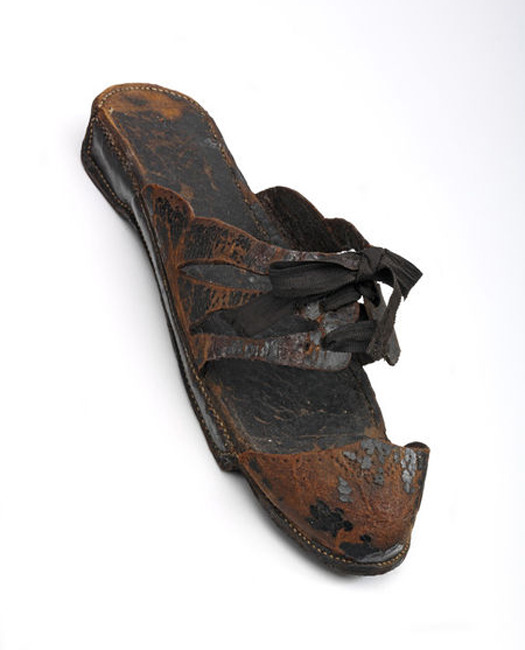
Great Britain, United Kingdom (made)
ca. 1825-1835 (made)
Leather, with raised cork sole
Only one overshoe of the pair survives. Overshoes of this type were known as 'promenade' or 'carriage' clogs. The leather straps and square toe cap would have fitted over a woman's shoe or boot, protecting the fragile silks and kid leathers from dirt and damp. As the sole was made of cork, the carriage clog would have been light to wear.
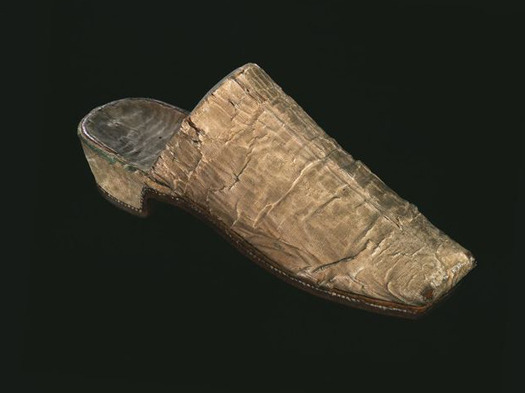
England, Great Britain (made)
1650s-1660s (made)
Leather and watered silk
Both men and women wore mules or backless slippers in the 17th century. A gentleman would have worn this pair as smart indoor leisurewear.They are now faded from the original salmon pink. This was a particularly fashionable colour in the 17th century. The shape of the heel and the pronounced square toe were both very fashionable in the middle of the 17th century.
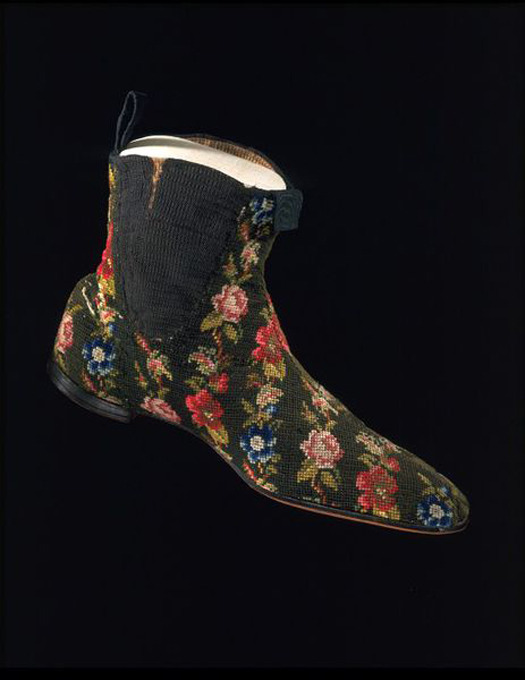
Great Britain, United Kingdom (made)
1845-1865 (made)
Canvas, with elastic side gussets, and embroidery in wool.
Half-boots (ankle boots) were popular for men from the 1830s right up to the Depression in the 1930s. Most were made of leather, though softer materials were popular for informal wear. The elastic-sided boot was patented in 1837 by J. Sparkes Hall of 308 Regent Street, London, as a result of experiments made with India rubber cloth. The elasticated side gussets eliminated the need for laces and button fastenings. Instead, the boots could simply be pulled on with the help of the fabric loop positioned at the back of the ankle.
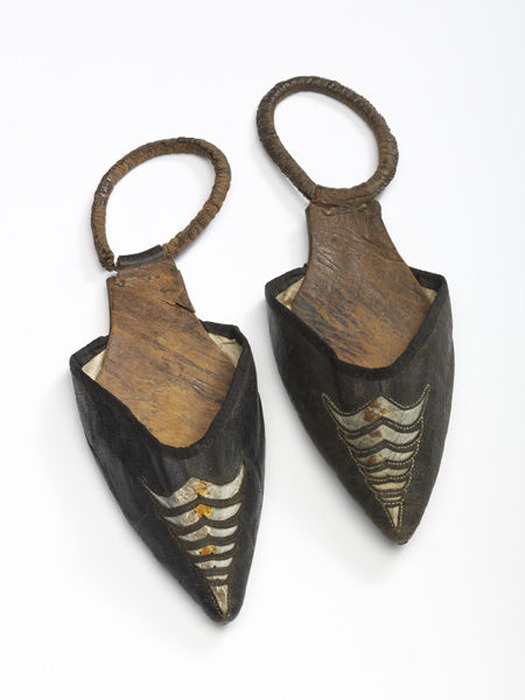
Great Britain, United Kingdom (made)
ca. 1797 (made)
Leather, with slashed design
This pair of protective overshoes, or toe-pieces, has a design of cut and punched leather. The effect is reminiscent of the slashed leather styles that were favoured in the 1530s and 1540s. The spring loop at the back would fit tightly over the small 'Italian' heel to hold the shoes in place.
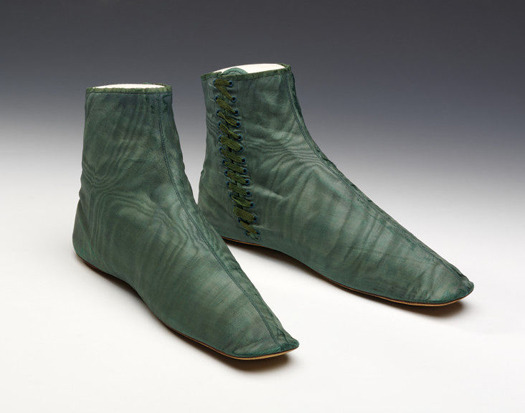
Great Britain, United Kingdom (possibly, made)
France (possibly, made)
1830s-1840s (made)
Leather sole, with watered silk uppers
This pair of side-laced, ankle-length boots of watered silk has a flat heel and square toe. As skirts increased in width and shortened in length, attention became focused on the foot and ankle. Brightly coloured silk boots or shoes would complement the richness of the gown. Sometimes they were chosen to match the sash or silk ribbons worn with the hat.
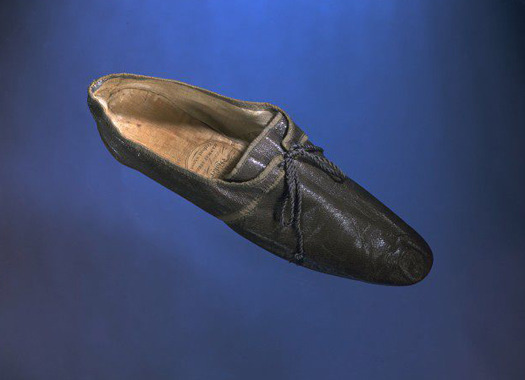
England, Great Britain (made)
1810-1820 (made)
Kid leather, lined with calico
A 'neat' foot was the ideal in the first half of the 19th century and this pair of women's shoes - simple, narrow and elegant - would help to create the favoured image. They are made of grey kid leather with a low heel and a latchet fastening across the narrow instep.
By this period there were several ways to purchase fashionable footwear, through shops and warehouses in the big cities, or fairs and local shoemakers in the provinces and countryside. With the ever-widening market, shoemakers began to use labels on the insoles, to advertise their wares.
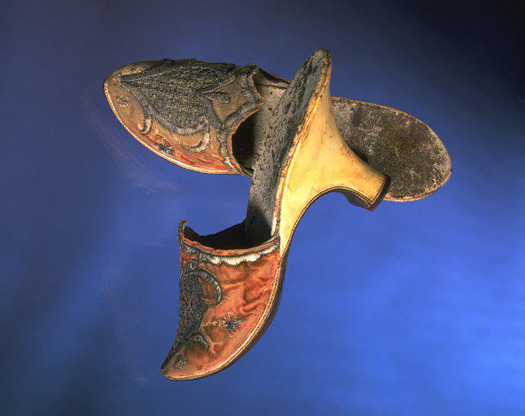
France (made)
1750s-1760s (made)
Leather soles, heels covered in kid leather, and velvet uppers
Women's high-heeled mules, commonly known as slippers, became increasingly popular for indoor wear and were even worn for dancing. These ones have a fairly high heel and a pointed toe. The velvet uppers are ornately decorated with metal thread.
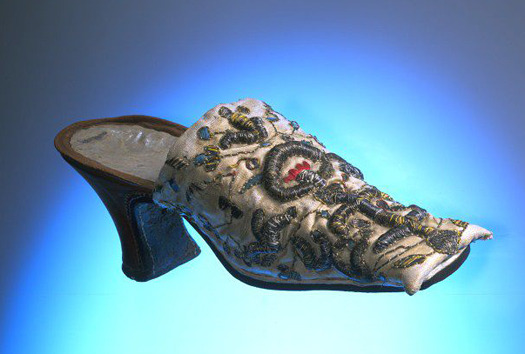
England, Great Britain (made)
1660s-1675 (made)
Wood, leather, kidskin, silk satin, silver thread, silver-gilt thread, silk thread, linen, hand sewing, hand embroidery
The ‘forked toe’ of this slipper was the height of fashion during the 1660s and early 1670s. The square toe has been exaggerated to droop over the sole at both corners. Typical of the late 17th century is the white rand, the narrow band of white leather between the sole and the upper. Such decorative footwear would have belonged to a lady of leisure. Slippers were usually backless; they were informal footwear and would have been worn indoors, probably with a nightgown.
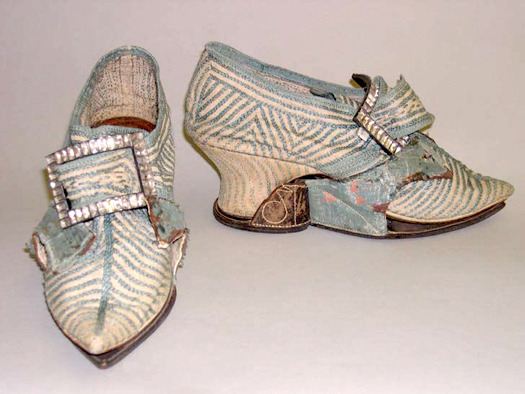
probably British
1740s
linen, silk, leather

